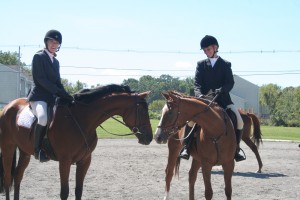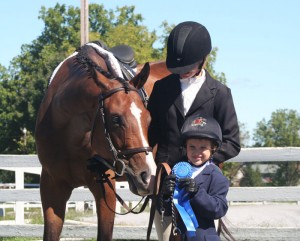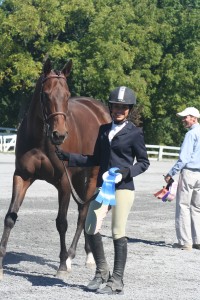When Pennsylvania horse trainer Cheryl Keller rolled into the Quentin Riding Club with 14 ex-racehorses in tow, you might say she had a point to make.
Dubbing her crew of riders and volunteers “Team Thoroughbred” they descended upon the show grounds of the all-breed event with the single-minded purpose of, well, showing off.
“It was a great marketing tool to take the horses out and show other riders how wonderful horses just off the track can be,” says Keller, a trainer for New Vocations Racehorse Adoption. “All the horses were so well mannered and they were a great tool to show the public what we’re doing with ex-racehorses, and that they’re so versatile.”
And they’re all from the Penn National racetrack!
With funds provided by the Pennsylvania HBPA, and training and adoption managed by New Vocations, twelve of the 14 OTTBs who participated in the show are being trained for new careers.
In a methodical approach, horses are first evaluated by track liaison Jennifer Hamm, a trainer at Penn National, who next decides whether they are suitable for the New Vocations re-training program.
Once a horse is deemed suitable, he is taken to Bowcrest Farm for training with Keller and her crew.
“I grew up around Thoroughbreds. My father bred them and I competed in eventing,” says Keller. “Years ago, before you saw Warmbloods become such a fad, all you saw were Thoroughbreds.
“I think people are starting to see it again. They’re starting to recognize that these are athletic, youthful horses, and they do have a place in the show world. The Warmbloods are lovely, beautiful animals as well. But here in America, we have a lot of Thoroughbreds who need jobs.”
And with every footfall on the showground sand, like a drumbeat for change, her Thoroughbreds shined in several classes.
Five-year-old mare Carli Rose looked so exquisite in the halter class, mere weeks after coming off the track, that as the judge pinned her with the blue ribbon, he said, “Don’t sell this horse.”
“She’s got a lot of appeal,” Keller says. “She’s nicely muscled and carries herself well.”
In a lead-line class for children under 6, bay gelding Raventronic won a first place with his young rider. “He’s the quietest horse in the barn,” Keller says, noting that he’s been up for adoption for a few months.
In the Walk/Trot Class for competitors 17 and under, bay mare Run with Sue and Carli Rose both placed in the ribbons.
Ex-racehorses also placed in older division and gamely participated in over-fences classes in the two- and three-foot division.

Lite Up the Mornin, left and Sweet Betty Lou in a quiet moment with riders Lisa Sincavage and Cheryl Keller
“Overall,” Keller says, “It was a wonderful experience.”
Ford agrees that Keller’s efforts to make a big presentation on behalf of the New Vocations Thoroughbreds were an unmitigated success.
“I applaud Cheryl Keller and Jennifer Hamm, and the many volunteers, for going to such lengths to make the day a success,” Ford says. “It was a huge effort to get 12 newly retired Thoroughbreds to their very first horse show.
And OffTrackThoroughbreds.com applauds them too, for doing all the hard work on behalf of our talented equine athletes, whom we love so much. Nice job!




“In a methodical approach, horses are first evaluated by track liaison Jennifer Hamm, a trainer at Penn National, who next decides whether they are suitable for the New Vocations re-training program.”
Susan, can your next article please let us know what happens to the horses that are not “suitable”? Do they enter New Vocations but not their “re-training program”? Or is there another rescue that Penn National and the PA HBPA are providing funds to for those horses injured that need surgery to remove bone fragments or to castrate a stallion? As the founder of CANTER in 1997, we were intaking over 100 horses a year from our small MI track and spending over $50,000 a year on surgeries because so many were unable to be used for anything unless their fractures were repaired or they were gelded. There was never a problem finding new careers for horses fully sound but unfortunately, the majority were not. Those lame horses are the ones most at risk of going to slaughter and need help the most. What is the safety net for them? Please let me know so I know where to refer people with horses at Penn National that need to retire.
Jo Anne, thanks for reading my story and writing to me. I’d be happy to ask New Vocations about the horses who are not suitable for retraining. I do not know the answer to your specific question, so I feel I can’t adequately respond. I do believe, however, that New Vocations, and CANTER, and all the other OTTB charities are doing their best to help as many horses as they can.
What a fantastic idea! Patty Dale of Three Plain Bays always resells OTTBs. I think she took a bunch to a local TB ONLY Show, nearby! My OTTB and I are enjoying Paper Chases in the Cheshire Hunt Country this fall. By far the TBs are the most gorgeous, hacking out!
I love the marketing program that these really successful rescues are adopting, getting the horses retrained (in what seems to be a very short window of time ;o) and out in the public eye so spectators can assess for themselves the athletic potential in every OTTB. These horses come with thousands of dollars of training from the track, and a short refresher course with a re-trainer puts their focus on their new job. And look at the results! Leadline class! Halter! Over fences! Ribbons galore and so much exposure. All good.